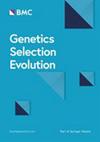Improving genomic prediction accuracy for methane emission and feed efficiency in sheep: integrating rumen microbial PCA with host genomic variation using neural network GBLUP (NN-GBLUP)
IF 3.1
1区 农林科学
Q1 AGRICULTURE, DAIRY & ANIMAL SCIENCE
引用次数: 0
Abstract
Methane emissions from ruminant livestock pose a significant challenge to mitigating climate change. Genomic selection offers a promising approach to reduce methane emissions, but prediction accuracy remains low due to the high cost of measuring methane emissions. Integrating rumen microbiome composition (RMC) data may improve genomic prediction accuracy, yet the high dimensionality of RMC data presents computational challenges. This study aimed to (1) evaluate the effectiveness of principal component analysis (PCA) for reducing RMC data dimensionality while retaining essential information, and (2) assess whether incorporating PCA-reduced RMC data as intermediate traits in a Neural Network Genomic Best Linear Unbiased Prediction (NN-GBLUP) model improves genomic prediction accuracy for methane emissions and feed efficiency traits in sheep. For the first objective, Principal Components (PCs) explaining 100% of variation effectively captured RMC information, with microbiability estimates closely matching those from the full dataset. For the second objective, the NN-GBLUP model incorporating PCA-reduced RMC data improved prediction accuracy compared to standard GBLUP methods. Prediction accuracy for methane emissions increased from 0.09 to 0.30 in train-test validation and from 0.15 to 0.27 in five-fold cross-validation using PCA components explaining 25% of total RMC variation. For residual feed intake, accuracy improved from 0.25 to 0.37 in train-test validation and from 0.25 to 0.34 in cross-validation. Optimal PCA components varied by trait, with 25% and 50% components showing the best results. Prediction accuracy did not improve for carbon dioxide emissions, live weight, and mid-intake, indicating trait-dependent microbiome influence. Principal Component Analysis reduced the dimensionality of rumen microbiome data while preserving essential biological information. The integration of these PCA-reduced data with host genomic information through an NN-GBLUP model substantially improved genomic prediction accuracy for methane emissions and feed efficiency in sheep. Principal components explaining 25% and 50% of the variation yielded the highest accuracy, whereas higher components (75% and 95%) reduced accuracy for methane traits. This approach shows promise for implementing genomic selection strategies to reduce methane emissions and improve feed efficiency in ruminant livestock in a computationally efficient manner, thereby contributing to climate change mitigation efforts in agriculture.提高绵羊甲烷排放和饲料效率基因组预测精度:基于神经网络GBLUP (NN-GBLUP)整合瘤胃微生物主成分分析与宿主基因组变异
反刍牲畜的甲烷排放对减缓气候变化构成了重大挑战。基因组选择为减少甲烷排放提供了一种很有前途的方法,但由于测量甲烷排放的成本很高,预测精度仍然很低。整合瘤胃微生物组组成(RMC)数据可以提高基因组预测的准确性,但RMC数据的高维性带来了计算上的挑战。本研究旨在(1)评估主成分分析(PCA)在保留基本信息的情况下降低RMC数据维数的有效性;(2)评估将PCA降低的RMC数据作为中间性状纳入神经网络基因组最佳线性无偏预测(NN-GBLUP)模型是否提高了绵羊甲烷排放和饲料效率性状的基因组预测精度。对于第一个目标,解释100%变异的主成分(pc)有效地捕获了RMC信息,微生物估计与完整数据集的估计密切匹配。对于第二个目标,与标准GBLUP方法相比,结合pca减少RMC数据的NN-GBLUP模型提高了预测精度。在训练检验验证中,甲烷排放的预测精度从0.09提高到0.30,在五重交叉验证中,使用PCA成分的预测精度从0.15提高到0.27,解释了总RMC变化的25%。对于剩余采食量,训练试验验证的准确度从0.25提高到0.37,交叉验证的准确度从0.25提高到0.34。最优PCA成分因性状而异,25%和50%成分表现出最佳效果。二氧化碳排放量、活重和中等摄入量的预测精度没有提高,表明性状依赖微生物组的影响。主成分分析在保留基本生物信息的同时降低了瘤胃微生物组数据的维数。通过NN-GBLUP模型将这些pca减少的数据与宿主基因组信息相结合,大大提高了绵羊甲烷排放和饲料效率的基因组预测精度。主成分解释25%和50%的变异产生了最高的准确性,而更高的成分(75%和95%)降低了甲烷性状的准确性。这种方法有望实施基因组选择战略,以计算效率高的方式减少甲烷排放和提高反刍牲畜的饲料效率,从而促进农业减缓气候变化的努力。
本文章由计算机程序翻译,如有差异,请以英文原文为准。
求助全文
约1分钟内获得全文
求助全文
来源期刊

Genetics Selection Evolution
生物-奶制品与动物科学
CiteScore
6.50
自引率
9.80%
发文量
74
审稿时长
1 months
期刊介绍:
Genetics Selection Evolution invites basic, applied and methodological content that will aid the current understanding and the utilization of genetic variability in domestic animal species. Although the focus is on domestic animal species, research on other species is invited if it contributes to the understanding of the use of genetic variability in domestic animals. Genetics Selection Evolution publishes results from all levels of study, from the gene to the quantitative trait, from the individual to the population, the breed or the species. Contributions concerning both the biological approach, from molecular genetics to quantitative genetics, as well as the mathematical approach, from population genetics to statistics, are welcome. Specific areas of interest include but are not limited to: gene and QTL identification, mapping and characterization, analysis of new phenotypes, high-throughput SNP data analysis, functional genomics, cytogenetics, genetic diversity of populations and breeds, genetic evaluation, applied and experimental selection, genomic selection, selection efficiency, and statistical methodology for the genetic analysis of phenotypes with quantitative and mixed inheritance.
 求助内容:
求助内容: 应助结果提醒方式:
应助结果提醒方式:


